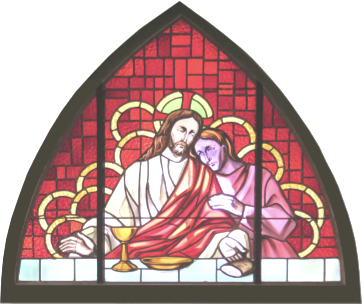Catholic Tradition: There is long tradition in the Catholic Church to cover all crucifixes, statues, and pictures in purple cloth from two Sundays before Easter until Holy Saturday. Under the old liturgical calendar prior to the Vatican II reforms in 1964, The Fifth Sunday of Lent, one week before Palms Sunday, was called Passion Sunday or Judica Sunday after the first work of the introit “Judge me, O Lord …” (Psalm 43). The veiling referred to the closing words of the Sunday gospel, “They picked up stones to throw at him, but Jesus hid himself, and went out of the temple” (John 8:59). The Lenten veil also expressed the sorrow of the Church at this time. As a matter of fact, the Roman Missal still says, in a note about the Saturday of the fifth Sunday of Lent, that this tradition may be observed, continuing the veiling until the beginning of the Easter Vigil. Also, the unveiling of the cross prior to the veneration on Good Friday is still and optional part of the liturgy (337, Klein: The Catholic Source Book).
Renewed 2011 Roman Missal: In the Dioceses of Canada, the practice of covering crosses and images throughout the church from this Fifth Sunday of Lent may be observed. Crosses remain covered until the end of the celebration of the Lord’s Passion on Good Friday, but images remain covered until the beginning of the Easter Vigil (239, Renewed 2011 Roman Missal: Canadian Conference of Catholic Bishops).
Historical Perspective by: Father Edward McNamara, professor of liturgy at the Regina Apostolorum Pontifical University. First of all, I would first like to recommend Monsignor Peter Elliott’s excellent guide “Celebrations of the Liturgical Year” published by Ignatius Press in 2002. It is a very useful resource for all those involved in the practical aspects of liturgical planning.
The duration of such veiling varies from place to place. The custom in many places is to veil from before first vespers or the vigil Mass of the Fifth Sunday of Lent while others limit this veiling from after the Mass of the Lord’s Supper on Holy Thursday.
In some places images and statues are actually removed from the church and not simply veiled, especially after Holy Thursday. Crosses are unveiled after the Good Friday ceremonies. All other images are unveiled shortly before the Mass of the Easter Vigil. Neither the Stations of the Cross nor stained glass windows are ever veiled.
The bishops’ conference may decide if the veiling during this period should be obligatory within its territory.
The veils are usually made of lightweight purple cloth without any decoration. The custom of veiling the images during the last two weeks of Lent hails from the former liturgical calendar in which the Passion was read on the Fifth Sunday of Lent (hence called “Passion Sunday”) as well as on Palm Sunday, Tuesday and Wednesday of Holy Week, and Good Friday.
For this reason the period following the Fifth Sunday of Lent was called Passiontide. A remnant of this custom is the obligatory use of the first Preface of the Lord’s Passion during the Fifth Week of Lent.
As Monsignor Elliott remarks, “The custom of veiling crosses and images … has much to commend it in terms of religious psychology, because it helps us to concentrate on the great essentials of Christ’s work of Redemption.”
Although this is true, the historical origin of this practice lies elsewhere. It probably derives from a custom, noted in Germany from the ninth century, of extending a large cloth before the altar from the beginning of Lent.
This cloth, called the “Hungertuch” (hunger cloth), hid the altar entirely from the faithful during Lent and was not removed until during the reading of the Passion on Holy Wednesday at the words “the veil of the temple was rent in two.”
Some authors say there was a practical reason for this practice insofar as the often-illiterate faithful needed a way to know it was Lent. Others, however, maintain that it was a remnant of the ancient practice of public penance in which the penitents were ritually expelled from the church at the beginning of Lent.
After the ritual of public penance fell into disuse — but the entire congregation symbolically entered the order of penitents by receiving ashes on Ash Wednesday — it was no longer possible to expel them from the church. Rather, the altar or “Holy of Holies” was shielded from view until they were reconciled to God at Easter.
For analogous motives, later on in the Middle Ages, the images of crosses and saints were also covered from the start of Lent. The rule of limiting this veiling to Passiontide came later and does not appear until the publication of the Bishops’ Ceremonial of the 17th century.
